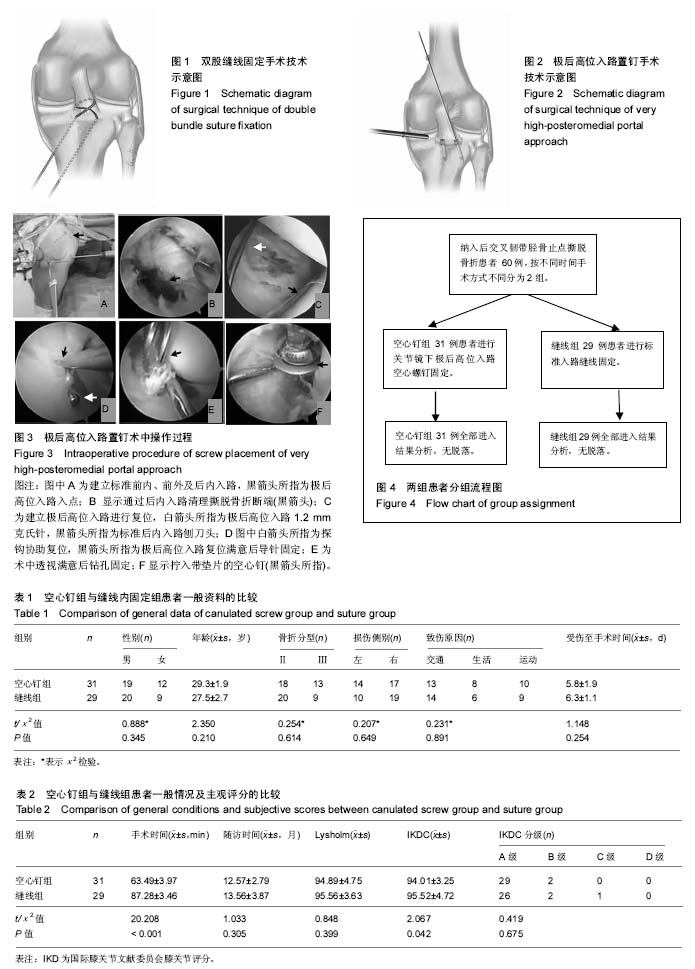| [1] 刘平,敖英芳.膝关节后交叉韧带及板股韧带临床解剖学研究[J].中国运动医学杂志,2008, 27(2):189-193..[2] Kim YM, Lee CA, Matava MJ. Clinical results of arthroscopic single-bundle transtibial posterior cruciate ligament reconstruction: a systematic review. Am J Sports Med. 2011;39(2):425-434.[3] Lu XW, Hu XP, Jin C, et al. Reduction and fixation of the avulsion fracture of the tibial eminence using mini-open technique. Knee Surg Sports Traumatol Arthrosc. 2010; 18(11): 1476-1480.[4] Cosgarea AJ, Jay PR. Posterior cruciate ligament injuries: evaluation and management. J Am Acad Orthop Surg. 2001;9(5):297-307.[5] Logan M, Williams A, Lavelle J, et al. The effect of posterior cruciate ligament deficiency on knee kinematics. Am J Sports Med.2004; 32(8):1915-1922.[6] Sasaki SU, da Mota e Albuquerque RF, Amatuzzi MM, et al. Open screw fixation versus arthroscopic suture fixation of tibial posterior cruciate ligament avulsion injuries: a mechanical comparison. Arthroscopy. 2007; 23(11):1226-1230.[7] Littlejohn SG, Geissler WB. Arthroscopic repair of a posterior cruciate ligament avulsion. Arthroscopy. 1995;11(2): 235-238.[8] Choi NH, Kim SJ. Arthroscopic reduction and fixation of bony avulsion of the posterior cruciate ligament of the tibia. Arthroscopy.1997;13(6): 759-762.[9] Wajsfisz A, Makridis KG, Van Den Steene JY, et al. Fixation of posterior cruciate ligament avulsion fracture with the use of a suspensory fixation. Knee Surg Sports Traumatol Arthrosc. 2012; 20(5): 996-999.[10] 吴术红,刘毅.关节镜下韧带末端缝扎固定治疗后十字韧带胫骨止点骨折[J].中华骨科杂志, 2011,31(7):779-183.[11] 林瑞新,董伊隆,杨国敬.关节镜下双套环技术治疗后十字韧带胫骨止点撕脱性骨折[J].中华骨科杂志,2010,30(12):1187-1191.[12] Kim SJ, Shin SJ, ChoiNH, et al. Arthroscopically assisted treatment of avulsion fractures of the posterior cruciate ligament from the tibia. J Bone Joint Surg Am. 2001; 83(5): 698-708.[13] Zhao JY, He B, Wang J. Arthroscopic treatment of acute tibial avulsion fracture of the posterior cruciate ligament with suture fixation technique through Y-shaped bone tunnels. Arthroscopy.2006;22(2):172-181.[14] Gui JC, Wang LM, Jiang YQ, et al. Single-tunnel suture fixation of posterior cruciate ligament avulsion fracture. Arthroscopy.2009;25(1): 78-85.[15] Chen SY, Cheng CY, Chang SS, et al. Arthroscopic suture fixation for avulsion fractures in the tibial attachment of the posterior cruciate ligament. Arthroscopy. 2012; 28(10):1454-1463.[16] Mao YQ, Dong P, Wang Y. Ganglion cysts of the cruciate ligaments: a series of 31 cases and review of the literature. BMC Musculoskelet Disord.2012;13:137.[17] Sabat DA, Jain P, Kumar V. Displaced posterior cruciate ligament avulsion fractures: a retrospective comparative study between open posterior approach and arthroscopic single-tunnel suture fixation. Arthroscopy.2016;32(1): 44-53.[18] Joshi S, Bhatia C, Gondane A, et al. Open reduction and internal fixation of isolated posterior cruciate ligament avulsion fractures: clinical and functional outcome.Knee Surg Relat Res.2017; 29(3):210-216.[19] 李建赤,黄必留,梁江声,等.锚钉内固定治疗后交叉韧带胫骨止点撕脱性骨折[J].中华关节外科杂志(电子版),2013,7(1):44-47.[20] Nicandri GT, Klineberg EO, Wahl CJ, et al. Treatment of posterior cruciate ligament tibial avulsion fractures through a modified open posterior approach: operative technique and 12- to 48-month outcomes. J Orthop Trauma. 2008;22(5):317-324.[21] 徐国浩,桂鉴超,周金明.关节镜下缝线固定手术治疗后交叉韧带胫骨止点撕脱骨折[J].中国骨与关节损伤杂志, 2017,32(2):208-209.[22] Meyers MH, McKeever FM. Fracture of the intercondylar eminence of the tibia. J Bone Joint Surg Am.1970; 52(8):1677-1684.[23] 赵金忠,蒋垚.关节镜下缝线固定治疗后交叉韧带胫骨止点撕脱骨折[J].中华创伤杂志,2003. 19(9):569-570.[24] Paine R, Lowe W. Comparison of Kneelax and KT-1000 knee ligament arthrometers. J Knee Surg. 2012;25(2):151-154.[25] 黄乐春,胡惠民,梁宇翔.膝关节功能评分量表评述.中国医药科学, 2016, 6(13):50-53.[26] Fanelli GC, Fanelli MG, Fanelli DG. Revision posterior cruciate ligament surgery. Sports Med Arthrosc. 2017;25(1):30-35.[27] Berg E.E. Comminuted tibial eminence anterior cruciate ligament avulsion fractures: failure of arthroscopic treatment. Arthroscopy.1993; 9(4):446-450.[28] 张青松,李涛,方禹舜,等.关节镜下“人”字缝线固定治疗后交叉韧带胫骨止点撕脱骨折[J].中华创伤骨科杂志, 2016,18(11):998-1000.[29] 张中兴,许峰,金伟.带线锚钉治疗后交叉韧带胫骨止点撕脱骨折21例报告[J].中国骨与关节杂志, 2016(2):120-12.[30] Jazayeri SM, Esmaili JA, Karami M. A safe postero-medial approach to posterior cruciate ligament avulsion fracture. Knee Surg Sports Traumatol Arthrosc. 2009; 17(3): 244-247. |
.jpg)


.jpg)